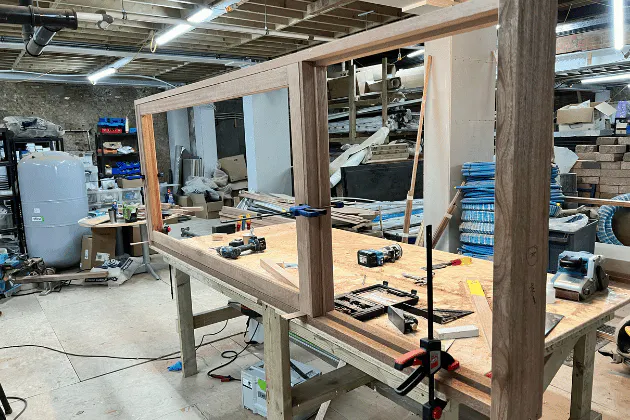Specialist Carpentry and Joinery
We excel in creating extraordinary wooden elements that require exceptional skill, technical expertise, and artistic vision. From heritage restoration and complex architectural features to innovative curved woodwork and bespoke timber structures, our master craftsmen deliver solutions that push the boundaries of traditional joinery.
Based in our fully-equipped Isleworth workshop, our team combines time-honoured techniques with cutting-edge technology to tackle challenging and unique projects.
Have a specialist joinery project in mind? Call us on 07508 018055 for an expert consultation.

Our Specialist Services
We offer advanced woodworking expertise across several specialist disciplines:
Heritage & Conservation
- Period Restoration - Authentic repair and replication of historic timber elements using traditional techniques
- Listed Building Joinery - Sympathetic conservation work compliant with heritage requirements
- Antique Furniture Restoration - Expert repair and conservation of valuable wooden furniture and fittings
- Traditional Joinery Techniques - Hand-cut dovetails, mortise and tenon joints, and traditional finishing methods
Architectural Joinery
- Curved & Shaped Woodwork - Complex curved staircases, arches, and radius work
- Structural Timber Features - Load-bearing joinery and specialist timber engineering
- Geometric Panelling - Intricate patterns and decorative wall treatments
- Sculptural Elements - Three-dimensional wooden features and artistic installations
Technical Specialisms
- Secondary Glazing Systems - Bespoke acoustic and thermal solutions for heritage properties
- Heavy Duty Fly Screens - Custom hardwood frames with specialist mesh for period properties
- Specialist Veneering - Book-matching, marquetry, and decorative inlay work
- Fine Finishing - French polishing, hand-waxing, and specialist paint techniques
Our Approach
Specialist joinery demands a meticulous approach from concept to completion:
1. Expert Assessment
We begin with a thorough evaluation of your project requirements. For heritage work, this includes documenting existing features, researching historical context, and understanding conservation guidelines. For contemporary specialist joinery, we analyse design challenges, structural implications, and material performance. Our team works closely with you to define a detailed brief that captures both technical requirements and aesthetic vision.
2. Specialised Design & Planning
Our technical designers develop detailed plans tailored to your project's unique demands. We produce comprehensive technical drawings, material specifications, and construction methodologies. For complex projects, we may create scale models or prototypes to test solutions.
3. Master Craftsmanship
Our workshop is equipped with both traditional hand tools and precision machinery, allowing us to combine time-honoured techniques with modern efficiency. Each component is meticulously crafted with exacting attention to detail, whether we're recreating historical joinery or realising innovative contemporary designs.
4. Precision Installation
The installation of specialist joinery demands exceptional skill and care. Our installation team has extensive experience handling delicate period features, managing complex fitting challenges, and working in sensitive environments. We use specialised equipment and techniques to ensure perfect positioning and integration of complex wooden elements. The final result is thoroughly inspected to confirm it meets our exacting quality standards.
FAQs
Extraordinary Woodwork Projects
From heritage restoration and curved staircases to intricate architectural features, our specialist craftsmen tackle the most challenging and unique timber projects with exceptional skill and precision.


